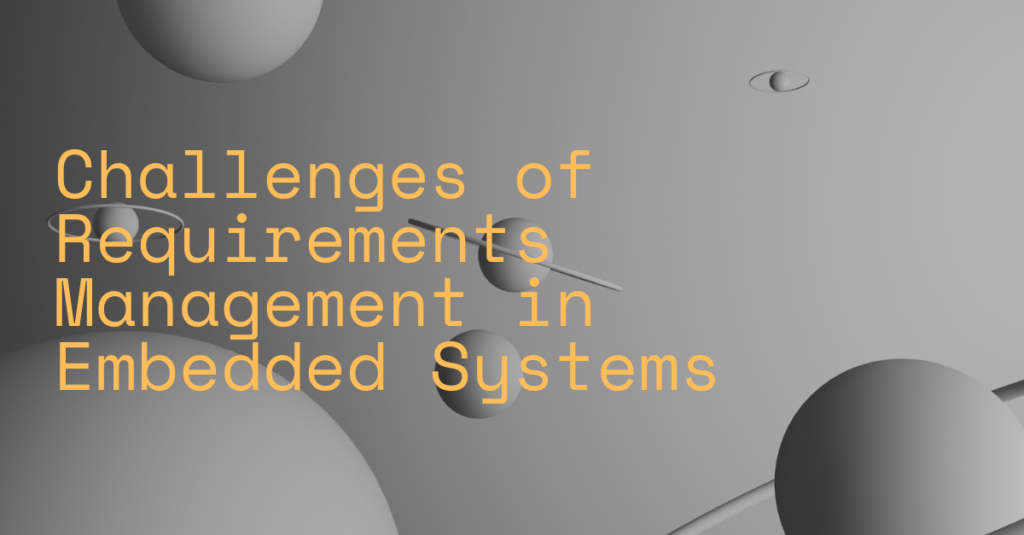Overview of embedded systems
Embedded systems are computer systems that are integrated into other products or devices. They are designed to perform a specific function or set of functions and are found in a wide range of applications, such as medical devices, automobiles, and industrial control systems.
The design and development of embedded systems present unique challenges, particularly when it comes to requirements management and can sometimes be a headache for project management.
In this article, we will explore the importance and challenges of requirements management for embedded systems with a focus on hardware development rather than software development.
The requirements management process
Requirements management is the process of gathering, analyzing, specifying, validating, and managing changes to the requirements of a system or product (in both hardware and software).
In embedded systems, requirements management is critical to the success of the project as it ensures that the end product meets the needs of the stakeholders and is fit for its intended purpose.
The requirements management process can be broken down into several stages:
- Gathering and documenting requirements: The first step in requirements management is to gather requirements from stakeholders, such as customers, users, and subject matter experts. These requirements should be clearly and specifically stated, and should be captured in a requirements document.
- Analyzing and prioritizing requirements: Once the requirements have been gathered, the process of requirements analysis now needs to start in order to identify any inconsistencies, ambiguities, or conflicts. Prioritization of requirements is also important, as it helps to ensure that the most important requirements are addressed first.
- Verifying and validating requirements: Verification is the process of checking that the requirements are complete, consistent, and traceable. Validation is the process of ensuring that the requirements are correct and that they meet the needs of the stakeholders.
- Managing changes to requirements: As the project progresses, requirements may change due to new information or changes in the project scope. It is important to have a process in place for requirements tracing, such as a change request process and a requirements traceability matrix.
Best practices for requirements management in embedded systems
Effective requirements management is essential for the success of embedded systems projects. Here are some best practices to keep in mind when managing requirements for embedded systems:
- Involving stakeholders early and often: It is important to involve stakeholders in the requirements gathering process as early as possible. This helps to ensure that the requirements are clearly understood and that the end product meets the needs of the stakeholders.
- Using clear and specific language in requirements: Requirements should be written in clear, specific language that is easy to understand. This helps to ensure that the requirements are unambiguous and that the development team has a clear understanding of what is expected.
- Adopting a traceability matrix: A requirements traceability matrix is a tool that can be used to trace the relationship between requirements, design, and test cases. It helps to ensure that all requirements are addressed and that changes to requirements are tracked.
- Continuously testing and verifying requirements: Requirements should be continuously tested and verified throughout the development process to ensure that they are met.
 Tools and technologies for requirements management in embedded systems
Tools and technologies for requirements management in embedded systems
There are several tools and technologies available to assist with requirements management for embedded systems. Some examples include:
- Requirements management software: There are several requirements management software options available, such as Jama Software and Valispace, which can be used to capture, manage, and track requirements.
- Model-based systems engineering: Model-based systems engineering (MBSE) is a graphical methodology that can be used to model the system and its requirements. This approach can be used to improve the traceability of requirements and to verify that they are complete and consistent.
- Agile development methodologies: Agile development methodologies, such as Scrum and Kanban, can be used to manage requirements in embedded systems projects. These methodologies focus on flexibility and rapid iteration, which can be beneficial in embedded systems development where requirements may change frequently.
- Real-time systems: Real-time systems are a type of embedded systems that require a guaranteed response time. These systems have specific requirements such as predictable response time, and can be developed using specialized software and hardware tools.
- Spreadsheet-based tools: Simple spreadsheet-based tools can also be used for requirements management, particularly for small-scale projects. These tools can be used to capture and track requirements and to generate a requirements traceability matrix.
Case studies
Successful requirements management in an embedded systems project: A case study of a medical device manufacturer that implemented a requirements management tool (Jama Software) and a traceability matrix to improve their product development process. As a result, they were able to reduce the number of bugs in their products, improve product quality, and accelerate time-to-market.
Challenges with requirements management in an embedded systems project: A case study of a company that develops industrial control systems. They faced challenges with requirements management due to a lack of clear and specific requirements, and a lack of a traceability matrix. As a result, they faced delays in the project, and struggled to meet the needs of their customers.
Summary and next steps
As embedded systems continue to become more complex, the importance of requirements management will only increase. In the future, we can expect to see more advanced tools and technologies being developed to assist with requirements management, and a greater emphasis on real-time systems.
Additionally, as the industry becomes more regulated, accessibility and safety requirements will have to be considered, which may require additional verifications and validations. With the right approach and tools, requirements management can help to ensure the success of embedded systems projects and ultimately lead to better products.

